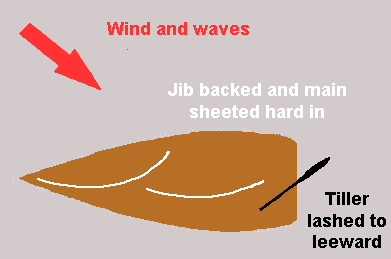Once the tide turned, I recovered my anchors from the vicinity of the hedge-fund Trimalchio's villa, the one with the eleven bathrooms, or whatever it was, on Mishaum Point, and headed up Buzzards Bay with the current and a following wind. Nice bright clear warm day, after the deathly bone-chilling moonlit haze of the previous night -- more Hecate's night than Selene's.
I have been pondering the physics of heaving-to. You can't -- well, I can't, or haven't yet been able to -- do it under jib alone. I seem to need some force from a source other than the jib to bring the bow through the wind and backwind the jib. Normally, of course, this is supplied by the mainsail. Here's how you end up, more or less:

You can see that the jib is trying to do one thing and the rudder is trying to do a different thing. The jib is trying to push the bow off the wind -- counterclockwise in this diagram, or to port. The rudder is trying to do the opposite -- push the bow up into the wind, or to starboard. The jib is stalled -- that is, the airflow over it is turbulent and isn't creating any lift -- and the mainsail isn't getting much wind at all, and what there is, is also turbulent. So the boat makes a very slight forward progress and also sags to leeward -- downwind -- so the net motion is more or less at right angles to the wind, and quite slow -- maybe a knot or so. The motion gets a lot calmer too, for reasons that I don't fully understand but the sages talk learnedly of.
This morning it occurred to me: How about using the motor instead of the mainsail to get the jib up into the wind and then through it? So I motored away from my anchorage, and once I was in reasonably deep water, and well clear of the clutter of islets and ledges and sandbars that litter Buzzards Bay like popcorn in a downscale movie theater, I unfurled the jib with the handy roller-furler and when it was drawing, put the helm down and came right through the eye of the wind and bang, I was hove-to.
I probably could have just shut the motor off at this point, just as I usually let the main luff once the tiller is lashed down, but being a cautious fellow, I just backed the throttle down to idle. The Scapegrace rode as demurely as a debutante -- a lot more demurely, actually, than any debutante I ever knew -- and edged slowly out into the channel, just where I wanted to be, without any help from me.
Now you may be wondering, what is the point of all this? Bear with me for a moment.
When you're sailing alone, the most tiresome, and tedious, and difficult part of the whole business is raising and dousing the mainsail. The jib is easy: there's a roller furler for that. You haul in the furler's halyard, and the jib wraps itself around the forestay and pretends it's not there -- quite effectively. To get it back, you uncleat the halyard and haul on the jib sheet, and hey presto, you have a jib again.
(This idyllic picture was to suffer some disruption later today. But I anticipate.)
So much for the jib. But the mainsail! On the Scapegrace, I have to hook up my harness and creep forward to the mast and heave on the halyard while trying to guide the worn old slugs on the luff of the sail into the little channel where they run on the mast.
(I know, a picture would make this clearer. Sorry.)
This process takes maybe ten minutes, and meanwhile, who's steering the boat, if you're motoring away from your mooring, or anchorage?
You could, of course, raise the main before you leave your mooring or anchorage. But then the wind catches it. It gets a lot more complicated to make to boat go where you want it to. You have the forward motion that you get from the motor, but then you also have leeway -- you're being pushed downwind as well as forward. Figuring out exactly where you're going to be in the next 30 seconds becomes difficult, and if you're in any kind of a tight spot -- with other boats nearby, or a narrow channel to squeak through, or a hull-devouring snaggletoothed rocky shore uncomfortably close under your lee -- why then, you may find yourself experiencing levels of anxiety which at my age I prefer to avoid.
So the discovery that I could heave-to with jib and motor solved a persistent pesky problem. I can motor away from anchor or mooring until I have a comfortable amount of searoom between me and anything I'd rather not hit, then unfurl the jib easily, heave-to, and raise the mainsail at my leisure.
And I really like my leisure.
To be continued.
No comments:
Post a Comment